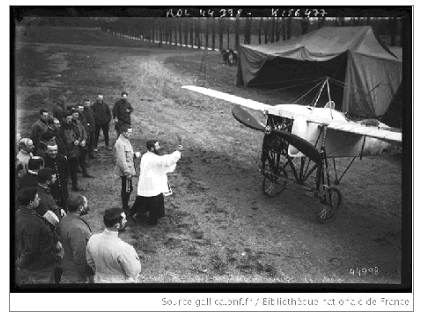Religious bias and pervasion of the believers' world: a religious acculturation of technology
In the 19th century new technologies raised both theological and liturgical problems to which religious leaders gradually found answers. We will here focus on the Catholic approach. Historian Michel Lagrée has shown that, contrary to Max Weber's early 20th century contention, the Catholic elites were not resistant to the mainstay of technological modernity. Aeronautics incidentally developed at a time when the churches had already integrated “progress” in their reading of reality. However this new technology roused in believers' mind questionings that had arisen upon the advent of the railway and the steamboat. Some of the questions discussed were the same as those raised by two other technical innovations contemporary with aeronautics, the cycle (push and motorbike) and the motorcar, but flight in its pioneering days (1900-1920) posed questions of its own.
For all that aviation placed humans in a super-natural order since it defied one of nature's laws, this was nothing new given that the question had arisen in the infancy of aeronautics with the first hot air balloons in the 1780s. Another question pertained to the dangerousness of an activity liable to challenge one religious moral principle: according to the traditional understanding of the Ten Commandments it is not appropriate or permissible to risk one's life unnecessarily without valid reasons. In the 1910s, theologians nevertheless allowed for that possibility if the act was undertaken for patriotic purposes. Air travel asked further moral questions. The pleasure accrued from the experience of speed and height further required that mastery over one's passions and behaviour be considered. Piloting as well as travelling, for a long time at great expense, required of believers that they scrutinised their relation to wealth. The fact that piloting was the preserve of a tiny elite called furthermore for some considerations on pride and modesty on behalf of those who could enjoy such an experience, the more so since pilots in the 1910-1950 period were cult figures. The growth of commercial airlines did however normalise this figure turning the flying hero into a sky bus driver.
What with the new technology accepted as a matter of fact, religious leaders sought to ease it into a familiar landscape, in a supernatural world construct. To this end, one of the most generalised practices adopted by the Catholics was ritual blessings and biblical referencing. Plane blessing was but the continuation of rites that had appeared with the development of the railway: stations and trains were indeed blessed according to a ritual codified in 1865 with a formula from Pope Pius IX[1] introduced in the Roman missal. A comparable ritual was codified for cars by the Roman Ritual in 1913 and 1925. Aviation received a specific text drafted by the Vatican's Sacred Congregation of Rites in 1920 (Acta apostolicae sedis, vol. 12, 1920, p. 475). One of the quotes frequently used in the process is drawn from Psalm 104 « “Thou [...] who maketh the clouds his chariot: who walketh upon the wings of the wind” »
or Ezekiel, Chapter 10. Blessings were equally frequent at air shows as from the 1910s. Such practices mixed the sacred with the worldly in a pattern that was in no way new since it was but a continuation of the way religious festivals had, since the beginning of the 20th century, doubled up with cycle races. The time assigned to worship during which the place or equipment was blessed was kept separate from the sporting event as is recorded for one of the earliest air shows ever at Port Aviation on April 1st 1909. There were blessings too for the pilots themselves who diced with death but got close to heaven. Thus was Beaumont[2] blessed by Pope Pius X when he won the Paris-Rome race in 1911. Blessings are also reported during the Great War though it is not possible to quantify the practice accurately for want of eyewitness testimonies. Obviously propitiatory, they would have aimed both to protect the pilot and, at a time when a good many clerics supported their fellow countrymen's patriotic endeavours, to empower the pilot in his mission against the enemy.

For the faithful, the confines of a sacred partly reassigned to pilots and aviation as a whole was blurry. The American historian Joseph Corn refers to a “secular faith”. As early as 1910, the image of the mystical hero was taking shape in the popular press. From 1916 on, it is enshrined, as the nations extol their Flying Aces, their top war pilots. In France the image would thereafter be vested in the Aeropostale's trailblazers in their mission to conquer the airspace. The religious authorities were not averse to using the popular pilot figure for edification purposes, especially when the much-loved ones were unapologetic churchgoers. Thus was Brindejonc des Moulinais[3] – a 20 years old pilot born in a military Catholic family and one of the pilots best known in France – presented as a paragon of Catholic faith. The interconnections between those realms were further illustrated on 30 January 1928 by the “baptism” of the first commercial aircraft of the Yugoslav flag carrier Aeroput, which would later serve on the Belgrade-Paris line. And there was no want for metaphors intertwining religion and aviation, wherein the aircraft served as a metaphor for apostolate . Bolder still, a 1931 address put Christ himself on a par with an aircraft, the former having no need to come down while still being available to all; the “fall” into “mortal sin” was compared to the airman's crash and the parachute to the “repentance” manifested in confession. The figures of the sportsman, of the Flying Ace, then of the master of the air were thus reframed for missionary purposes, commandeering the more profane aura of these men set by the public in a class of their own but whose outspoken faith alluded to their humility.






